Fix the root cause of No-Call No-Show with help from TeamSense
Table of Contents
- What Is A No Call No Show Write Up?
- No Show No Call Write Up Templates And Examples
- Why Do You Need to Address No Call No Shows?
- What is a No Call No Show Policy?
- Consequences of No Call No Show
- How To Communicate With The Employee Post-Incident
- Communication Strategies
- Legal Considerations
- How Can TeamSense Help Reduce No Call No Shows?
- Final Thoughts On No Call No Show Write Ups
No one likes having to discipline an employee, but when a serious infraction occurs, like not calling or showing up for work, it's necessary. If this is the first time that a particular employee has had an issue, issuing a no call no show write-up, or warning letter is a great way to document the problem. Depending on the circumstances, you may be tempted to let it slide, but when an employee is absent and doesn’t call off to report it, it disrupts the entire schedule and team. Instead of focusing on your planned tasks, you now have to adapt, ask other team members to take on additional responsibilities, and maybe even pick up the slack yourself.
In this guide, we will walk you through the steps of writing an effective no-call, no-show write-up, with an example letter you can use. We'll cover what to include in the warning letter, how to approach the conversation with the employee, and tips to prevent future no-call no-shows. By the end, you'll be equipped to handle these situations smoothly and avoid hair-on-fire moments due to unreported and unplanned absences.
What Is A No Call No Show Write Up?
A no call no show write up is your go-to document for officially addressing an unannounced and unreported employee absence - otherwise known as a no call no show. The warning letter records all the essential details of the absence. Including the employee’s name, date of absence, and which company attendance policy or policies were broken by the absent employee.
It should also include the impact the absence had on the company. Did the no call no show disrupt any critical projects? Did it cause delays or require a team member to cover additional jobs? When you highlight the consequences of the employee’s absence, it can help demonstrate how critical this situation is.
We all have blinders on sometimes and forget how our actions affect others and need a reminder. The write up should also mention any previous no call no show infractions to demonstrate a pattern (if there is one). Lastly, provide the employee an opportunity to explain their absence.
When Do You Need A No Call No Show Write Up?
A no call no show write-up is necessary whenever an employee fails to report their absence without prior notice or a valid reason. Here are some specific scenarios when you should consider issuing a no call no show warning letter:
- First-Time Offense: If this is the first time the employee has failed to show up or call in, a write-up serves as a formal warning and documentation of the incident as set in the company no call no show policy. This helps set clear expectations for future behavior.
- Repeated Absences: If the employee has a history of excessive absenteeism, it’s crucial to have documentation of each occurrence. A pattern of no call no shows indicates a serious issue that needs to be addressed promptly, and may even require a termination letter.
- Impact on Operations: When an employee’s absence causes significant disruption to your operations, it’s important to document the impact. This includes situations where other team members have to take on extra work or where critical tasks are delayed.
- Policy Violations: If your company has a specific attendance policy that the employee has violated, a write-up is necessary to enforce these rules consistently. This ensures fairness and accountability across the team.
- Failure to Improve: If the employee has already received a verbal warning or previous write-ups for similar issues, another no call no show write-up is needed. This helps build a case for further disciplinary action if the behavior doesn’t improve.
Issuing a no call no show write-up helps maintain a structured and professional work environment. It communicates to your employees that attendance is critical and that unreported absences will not be overlooked.
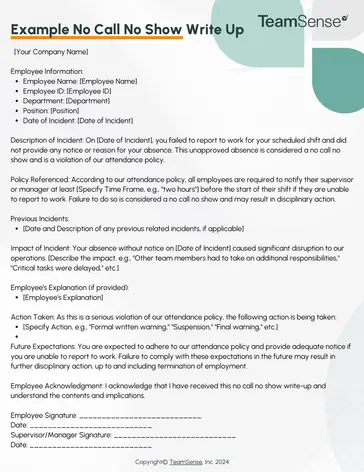
No Show No Call Write Up Templates And Examples
A no call no show warning letter can be a standard process. Having a template on hand for when this event occurs can help make this time consuming process move faster. By using a template, employers can also ensure that there is consistency with everyone in this process. Let’s look at some examples:
Examples of No Call No Show Write Ups
There are a handful of approaches when sending out a no call no show document. A formal and professional approach is one of the more standard ways to handle this process. Describing the incident, the impact it had on the team, and disciplinary actions to follow is needed in this situation.
There is always a casual and friendly report. This could be used in a less formal setting, however, it is not recommended especially for repeat offenders. A strict and disciplined approach is on the opposite side of the spectrum from casual and friendly. This option is more harsh and maybe shouldn’t be used for one time offenders.
However, if this is a continual problem with this specific employee, this approach might be recommended. There is also the empathetic and supportive approach. Having this type of language sprinkled in throughout is important, especially for people who are receiving this letter for the first time, to make sure the employee still feels supported.
What to Include in a No Call No Show Write-Up
Creating a comprehensive no call no show write-up is essential for documenting the incident and maintaining clear communication with the employee. Here are the key elements to include in the write-up:
1. Employee Information
Include basic details about the employee involved:
- Employee Name
- Employee ID
- Department
- Position
2. Date of Incident
Clearly state the date when the no call no show occurred. This helps in tracking patterns of behavior if similar incidents happen in the future.
3. Description of Incident
Provide a detailed description of what happened. Mention the scheduled shift, the fact that the employee did not report to work, and that no notice was given.
4. Policy Referenced
Refer to the specific attendance policy that was violated. Include a brief description of the policy and the required procedures for reporting absences.
5. Previous Incidents
If applicable, document any previous no call no show incidents or related attendance issues. This provides context and demonstrates whether there is a pattern of behavior.
6. Impact of Incident
Describe how the employee's absence affected the team and operations. This section should highlight the consequences of the no call no show on productivity and workload distribution.
7. Employee's Explanation
Include a section for the employee to provide their explanation or reason for the absence. This ensures that their side of the story is recorded.
8. Action Taken
Specify the disciplinary action being taken as a result of the no call no show. This could range from a formal written warning to suspension or final warning, depending on the severity of the infraction and the employee's history.
9. Future Expectations
Clearly outline what is expected from the employee moving forward. Emphasize the importance of adhering to the attendance policy and the potential consequences of future violations.
10. Employee Acknowledgment
Include a section for the employee to sign, acknowledging that they have received and understood the write-up. This ensures that there is a formal record of the communication.
11. Supervisor/Manager Signature
The supervisor or manager who is issuing the write-up should also sign the document, confirming that the procedure has been followed correctly.
Including these elements in your no call no show write-up ensures that the incident is thoroughly documented, communicated effectively, and that all parties understand the implications and expectations moving forward.
Customizable Template For No Call No Show Write Up
Here is an example of a customizable template that you can use to make this process as efficient as possible:
[Your Company Name]
No Call No Show Write-Up
Employee Information:
- Employee Name: [Employee Name]
- Employee ID: [Employee ID]
- Department: [Department]
- Position: [Position]
- Date of Incident: [Date of Incident]
Description of Incident: On [Date of Incident], you failed to report to work for your scheduled shift and did not provide any notice or reason for your absence. This unapproved absence is considered a no call no show and is a violation of our attendance policy.
Policy Referenced: According to our attendance policy, all employees are required to notify their supervisor or manager at least [Specify Time Frame, e.g., "two hours"] before the start of their shift if they are unable to report to work. Failure to do so is considered a no call no show and may result in disciplinary action.
Previous Incidents:
- [Date and Description of any previous related incidents, if applicable]
Impact of Incident: Your absence without notice on [Date of Incident] caused significant disruption to our operations. [Describe the impact, e.g., "Other team members had to take on additional responsibilities," "Critical tasks were delayed," etc.]
Employee's Explanation (if provided):
- [Employee's Explanation]
Action Taken: As this is a serious violation of our attendance policy, the following action is being taken:
- [Specify Action, e.g., "Formal written warning," "Suspension," "Final warning," etc.]
Future Expectations: You are expected to adhere to our attendance policy and provide adequate notice if you are unable to report to work. Failure to comply with these expectations in the future may result in further disciplinary action, up to and including termination of employment.
Employee Acknowledgment: I acknowledge that I have received this no call no show write-up and understand the contents and implications.
Employee Signature: ___________________________
Date: ___________________________
Supervisor/Manager Signature: ___________________________
Date: ___________________________
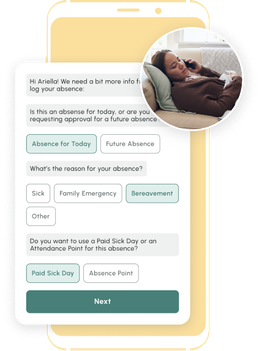
No one wants to talk to their boss or a 1-800 stranger to call off. Text changes everything - Reducing No Call No Shows.
Why Do You Need to Address No Call No Shows?
What may seem like a harmless disappearance to an employee is actually a large ripple effect through the company. Addressing a no call no show absence is crucial for creating and maintaining a healthy work environment.
Team Impact: Like throwing a wrench into the gears of a well-oiled machine, no call no shows affects everyone on your team, not just one person. Addressing these incidents makes sure everyone is on the same page and understands the importance of their communication and reliability.
Company Culture: Every workplace has its own set of rules and expectations. Ignoring a no call no show situation sends a message that those rules don’t matter. Addressing a no call no show situation reinforces a culture of accountability and responsibility.
Pattern Recognition: One missed shift could be a fluke, but a series of no call no shows suggests a deeper issue. Documenting helps in recognizing the patterns and an opportunity to intervene before no call nos shows become a chronic issue.
Operational Efficiency: No call no shows are like rogue waves rocking the boat threatening to capsize the whole operations. Smooth operations depend on everyone pulling their weight, and by addressing them promptly you help keep things running smoothly.
Legal Protection: Keeping clear documentation of no call no shows protects your company in case of legal disputes or challenges down the line.
Addressing no call no shows is not about discipline. Rather, it is all about creating and maintaining a positive workplace culture, protecting your company's interests and ensuring operational efficiency.
How A No Call No Show Write Up Differs From An Absenteeism Write Up
Think of a no call no show write up as a sudden bolt of lightning while absenteeism is more of a slow burn. Like a lightning bolt, no call no shows are unplanned absences where no prior notice is given. These are sudden absences that need to be addressed.
In contrast, absenteeism write-ups deal with a persistent and long-standing pattern of missing work - like a slow burn. Absenteeism warning letters set clear expectations and address ongoing behavior to ensure reliability and consistency in future attendance. Each of these are used to manage employee attendance. A no call no show write up addresses the sudden and unforeseen, on the other hand absenteeism write ups acknowledge habitual and persistent behavior.

What is a No Call No Show Policy?
A no call no show policy spells out what an employee must do if they can’t make it to work - no ghosting allowed! It highlights the consequences of not calling work ahead of time. With this policy in place, everyone is accountable for their actions, and the workplace can run as smoothly as possible.
How Does a No Call No Show Write Up Fit Within The Policy?
A no call no show write-up is used to enforce the no call no show policy. The no call no show policy explains that not calling into work is unacceptable and that there will be consequences. One of those consequences is the warning letter.
How Do You Inform Employees Of The No Call No Show Policy?
Keeping everyone in the loop, even if it is something people prefer not to deal with, is important to making your company go round. There are a couple of ways to make this process as fun and engaging as possible. Here are a couple of ways to spread the word to make sure everyone is on the same page:
Employee Handbook: A handbook is meant to answer all your questions about how to act in the workplace. Included in this is the no call no show policy. Ensure everyone receives a copy!
Staff Meetings: Sprinkling reminders of the policy into your regular staff meetings is a great way to keep the policy fresh in everyone’s mind. This is a great tool to use if you are noticing a rise in no call no show incidents.
Visual Reminder: Getting creative with posters, handouts, or other fun visuals in common areas like the break room by the coffee machine can be a great reminder to your employees.
Training Sessions: Training sessions or orientation programs should cover all key company policies - which involves the no call no show write up policy. Demonstrate why this policy matters in this session. Real life examples are great in this environment.
Digital Communication: Periodic points of communication whether it be an email, text message, call or more can be great reminders of this policy. TeamSense provides a great platform to send out mass notifications quickly and with ease.
Acknowledge and Review: Have employees acknowledge and demonstrate their understanding of the no call no show policy by signing an agreement.
Finding an engaging method to inform and remind employees of the no call no show policy will make sure the policy isn’t just another forgotten page in the employee handbook.
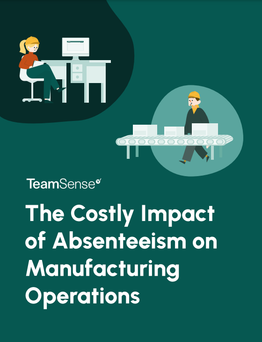
The Costly Impact of Absenteeism on Manufacturing Operations
Learn how chronic, unplanned absenteeism is a costly impediment to manufacturing productivity and efficiency, and how you can reduce absenteeism.
Consequences of No Call No Show
The consequences can range on no call no shows depending on a each individual circumstand, did they provide a valid reason? Is it the second offense? How is the employee responding? Let’s explore some of them actions below:
Verbal Warning: A friendly but firm reminder can be used for first-time offenders, but we recommend going the written route, even if it's the first time. Having documentation eliminates the he said she said situations.
Written Warning: This official document lays out the incident, reminds employees of the policy, and warns of further consequences if this behavior continues.
Suspension: Following continuous no call no show write up, suspension might be necessary.
Termination: No call no shows that become a pattern and disrupt the workplace time after time may lead to termination as the final step. This is a last resort but necessary to maintaining an efficient workplace.
Having clear consequences, you emphasize the importance of reliability in the workplace and that communication is key.
What Are Valid Reasons For No Call No Shows?
Though it may seem like there are not Far and few in between, there are a couple of legitimate reasons to no call no show. Let’sl explore a few of them.
Medical Emergencies/Unplanned Hospitalization: Unexpected hospitalizations or illnesses can throw your day immediately into chaos. Notifying your boss in these situations isn’t exactly at the top of mind.
Family Emergencies: A serious illness or accident of a loved one requires all hands on deck. Phone calls and logistics have to be planned at the last minute, and calling out of work might slip through the cracks.
Personal Safety Issues: While rare, crimes or break-ins do happen. Work can take a backseat when you are trying to get yourself back to safety.
Natural Disasters: Think earthquakes, hurricanes, tornadoes, or more. Mother nature’s plans do not always align with yours. This can disrupt signals to call into work. And, besides, usually in this situation your first priority is to stay safe rather than call out of work.
Technological Glitches: One of the more frustrating things in this world is when technology doesn’t work. We’ve all had that moment where we wanted to throw our phone across the room at some point. When you can’t get the message out, you're stuck with a no call no show situation.
It is important for employers to bring a bit of empathy and understanding to the table because sometimes life just happens.
How To Communicate With The Employee Post-Incident
You’ve had a no call no show employee, now what? Communication is needed here to get in touch with the employee post-incident. First on the agenda is to try to schedule a one-on-one chat with the employee in question. Be sure to address the incident directly, asking them what happened.
In this conversation, share your concerns about the impact of their absence on the team and workplace overall. Additionally, touch on the no call no show policy (this is a great place to remind them of the agreement you hopefully had them sign!).
Here is where one of the more difficult parts of communication comes into play: listening to the employee.
Give them a chance to explain their side and why they did not longer show up on their scheduled shift. It is key to show empathy in this situation. Once you have heard them out, determine the best course of action. Was their reason for being absent because their alarm didn't go off, or was it more serious, like a child being admitted to the ER? These are all important factors in determining next steps. Lastly, try to end on a positive note. Remind the employee of their value and your confidence in their ability to learn and grow from this experience.
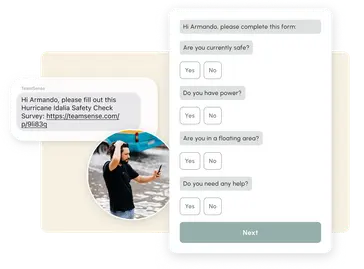
Communication Strategies
Employee communication can come in many forms. In order to be as effective as possible, you need to use what is best for your workforce (for instance, hourly employees lack company email addresses, so email is out!).
An open-door policy is a great way to foster communication. We’re not talking about physical doors here. An open-door policy means fostering an environment where your team feels comfortable coming to managers with any concerns.
Regular check-ins also provide an opportunity to drop friendly reminders of the attendance policy regarding no call no shows. Lastly, sending out reminders via messaging platforms.
Effective Communication Channels
When it comes to tracking down employees after a no call no show situation, choosing the right communication channels can keep things running smoothly and efficiently. Here are some channels you can use to do this:
Phone Call: This is often the most direct and quickest way to reach an employee. This could also add a personal touch to the situation.
Text Message: If unable to reach by phone call, sending a text could be a good alternative. Keep this short, to the point, and ask to speak with the employee over the phone or in person if possible.
Instant Messaging: Platforms such as Slack or Teams are another way to quickly reach the employee. Oftentimes, though, if employees aren't responding via their phone, it is rare they will be reached via these methods.
In-Person Meeting: This is a chance to connect more on a personal level and hash things out in real-time. This allows for face-to-face communication and adds a human level component to the case.
Legal Considerations
It is important to know some of the labor laws that are relevant in this case scenario. We’re not all lawyers and it is simply not our job to know all the rules and regulations. There are a couple of key legal considerations to keep in mind during the no call no show absent process.
Know Your Employment Contracts and Policies: Start with the basics that clearly explain the no call no show rules and consequences. This can provide a legal basis for disciplinary actions that may need to be taken.
Stay Within State and Federal Laws: Laws such as wrongful termination and employee rights are important to keep in mind. Stay within the legal loop to stay in the right.
Document, Document, Document: This can be vital in the case of legal action.
At the end of the day, legal counsel is your ally. Keeping legal tips and tricks in your toolkit can help you deal with no call no show situations like a pro.
Relevant Labor Laws
There is no need to know all the ins and outs of labor laws. Here are a couple, however, that would be helpful to be aware of when going through this process.
Fair Labor Standards Act (FLSA): Your go-to law for minimum wage, recordkeeping, and overtime pay regulations.
Family and Medical Leave Act (FMLA): If the no call no show is due to a reason relevant with FMLA, the employee might be protected. FMLA gives employees up to 12 weeks of job protected, unpaid leave.
Americans and Disabilities Act (ADA): Any employee with a disability is required to be accommodated. It is important to think if the absence is linked to a disability and if the proper accommodations can and were made. Being fair and inclusive is key.
Occupational Safety and Health Act (OSHA): Think safety. It is imperative to ensure any disciplinary actions don’t violate any employee’s rights - especially if safety concerts are involved in this situation.
While this list is not exhaustive, keep laws like these and others in your toolkit. This will ensure fairness and legality when dealing with no call no show absences.
Mitigating Potential Legal Risks
There are two important elements to mitigate potential risk: communication and crystal clear policies. Communication in this sense goes both ways. Whether it is employee to employee, manager to employee or vice versa, there should be continual open lines of communication.
One of the things that should be continually communicated through this process is the company policies. Continuing to set these expectations of employees will makes sure everyone knows the drill. When people are not left in the dark, they can make clear decisions on their own as to how they want to proceed.
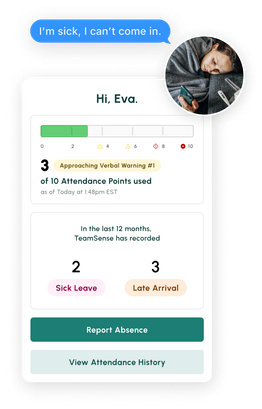
How Can TeamSense Help Reduce No Call No Shows?
A common theme throughout this post is communication. There are a couple of tools to help make this easier throughout a large company. One of those is TeamSense.
What Is TeamSense
TeamSense is your go to company for providing quick and easy ways to communicate with your employees. Through a text message, employees can call out of work with ease and speed. This process only takes approximately 45 seconds. Additionally, TeamSense can send out mass notifications via text message to help employees all get on the same page. Communication is a common and important theme and finding ways to communicate more effectively is key to having your company run as smoothly as possible. TeamSense does just that.
How TeamSense Handles Absentee Reporting
When it comes to reporting absences, TeamSense does it quick and easy. U
sing TeamSense, employees text a number and input why they are calling out of work today - that's it! Taking only approximately 45 seconds, TeamSense is clearly the fastest and most efficient option. It is also found that 97% of employees prefer text over phone call.
By providing this option, there is a greater chance that your employees will follow protocol and call out of work. Once these absences are reported, TeamSense immediately will notify the management and HR team so they can adapt quickly. By not having a lag time between the employee reporting and management notified, it allows for more efficient work flow and communication.
Final Thoughts On No Call No Show Write Ups
No call no show write ups are an unfortunate and frustrating part of the job but crucial to get right. Ensuring that thorough communication throughout, following proper legal laws, and following company guidelines is what will help you get this task done. We also covered ways to communicate with your team effectively and efficiently, finding that TeamSense is a great tool to use.
About the Author

Jackie Jones, Employee Engagement & Attendance Specialist
Jackie Jones has over three years of experience helping HR teams improve employee morale, reduce absenteeism, and create happier, more engaged workplaces. With a strong background in employee relations and attendance management, she brings practical strategies and insights that support frontline teams and the HR professionals who lead them.


